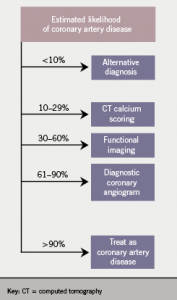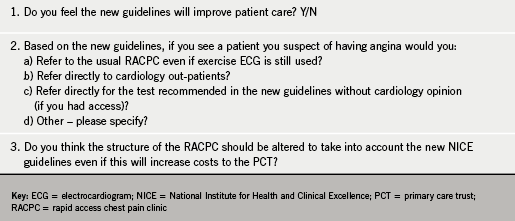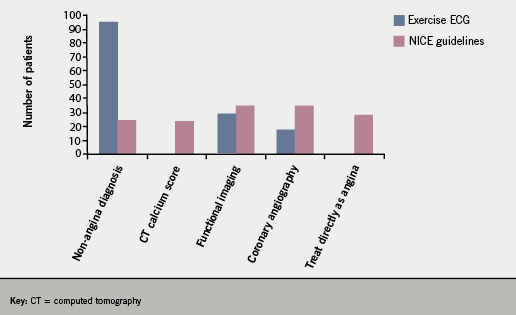National Institute for Health and Clinical Excellence (NICE) guidelines for the management of chest pain suggest a care pathway based on symptoms and clinical risk, which differs from that currently used in most hospitals. To compare the impact on workload, and costs of these guidelines with the current ‘exercise electrocardiogram (ECG)’-based service, a retrospective review of 150 patients referred to our rapid access chest pain clinic was performed. We compared investigations under the current system with that expected under the NICE guidelines. Cost analysis was performed to compare the two methods. GP questionnaires investigated likely changes in primary care referrals.
Introduction
The National Service Framework (NSF) for Coronary Heart Disease, published in 2000,1 set modern standards for the management of patients presenting with symptoms consistent with angina. These standards aimed to identify subjects with angina, provide rapid investigation and symptom relief, and reduce the risk of coronary events. The guidelines led to the widespread development of rapid access chest pain clinics (RACPC) to provide specialist assessment within two weeks of GP referral. Most UK chest pain clinics have adopted an exercise electrocardiogram (ECG) model of approach, where patients are risk-stratified based on clinical history, examination and exercise ECG.2-4 These clinics may also provide access to additional cardiac services such as echocardiography, functional testing (stress echo, stress magnetic resonance imaging [MRI] or nuclear stress tests) and coronary angiography, but this will vary greatly from centre to centre. Overall, the NSF targets have been successful in improving patient access to cardiology services despite initial concerns.5,6 However, there remains concern as to the sensitivity and specificity of the current model of screening, leading to the potential to misdiagnose patients and deny potentially life-saving therapy.
The National Institute for Health and Clinical Excellence (NICE) have recently published new guidelines for the management of patients with new onset of chest pain.7 This document describes a new model for the assessment of such patients in which the percentage clinical risk is initially calculated based on clinical history, sex and the presence or absence of risk factors, followed by diagnostic testing dependent on the estimated risk. This model aims to improve the sensitivity and specificity of diagnosis and, hence, improve patient care. Implications on cardiology service workloads are likely to be significant and may require increased capacity for diagnostic imaging and coronary angiography. Moreover, additional costs to the National Health Service (NHS) may be incurred. The aim of this study was to compare the impact on workload and cost implications of implementation of the new NICE guideline-based system with the current exercise ECG-based service.
Materials and methods
We retrospectively reviewed the medical notes of 150 patients referred to our RACPC over a one-month period. Criteria for referral to our clinic are: new onset exertional chest pain where angina is suspected, or patients with known angina who have developed limiting symptoms. Exclusion criteria are: suspected ongoing acute myocardial infarction (MI), known or suspected significant valve disease or inability to perform an exercise ECG. Data were gathered on clinical history and risk factors. We tracked each patient’s clinical journey to assess which investigations were required before discharge or final diagnosis. We then estimated the percentage clinical risk using the NICE guidelines-based system and used these to estimate the investigations that would be required if we converted to these guidelines. NICE guidelines specify that angina pain is:
- Constricting discomfort in the front of the chest, or neck, shoulders, jaws or arms.
- Precipitated by physical exertion.
- Relieved by rest or glyceryl trinitrate (GTN) within five minutes.

As per the guidelines, if a patient has all three of these features they are considered to have typical anginal features, if two are present they are considered to have atypical anginal features and if one or less are present the symptoms are considered to be non-anginal. Once the nature of pain is established, the estimated clinical risk of angina is calculated using the tables provided in the guidelines, and the further investigations required are dependent on this risk (figure 1). For those patients with previous confirmed history of coronary artery disease (CAD), in whom the diagnosis of angina was unclear, a functional imaging test would be recommended. Cost analysis was performed by estimating the total cost to the NHS based on each system. As there are currently no fixed NHS tariffs for all the tests implicated, we based the cost of each individual test on data published by Dewey and Hamm,8 which was taken into account in forming the NICE guidelines. For nuclear functional imaging, which is not included in this study, we used a cost of £160 based on our current hospital tariff.
We analysed baseline investigations only and did not include any additional tests that may be required on an individual patient basis, as it is not possible to estimate the number of patients that would require such testing. The likely impact on GP referrals was assessed by sending questionnaires to each referring practice to enquire as to whether referral patterns would likely change based on these new guidelines (table 1).

Results
Data were available in 145 of the 150 case notes reviewed. Median age was 60 years (range 31–85) and 60.3% of patients were male. Past medical history was as follows: 13.7% were diabetic, 52.3% had a history of hyperlipidaemia, 35.6% had a history of hypertension, 56.2% were current or recent smokers.
Current exercise ECG system
Data on investigations performed on 145 patients were reviewed. Following clinical history and examination, 139 (95.9%) underwent an exercise ECG, of whom 18 (12.4%) underwent coronary angiography, seven (4.8%) underwent stress nuclear imaging and 22 (15.2%) underwent stress echo. Of the remaining 98 patients, 94 were discharged to their GP with a diagnosis of non-cardiac chest pain, and four were followed in cardiac out-patients for future review of symptoms.
NICE guidelines system
Based on clinical history, 9% of patients were considered to have typical anginal features, 30.3% were considered to have atypical anginal features and 60.7% were considered to have non-anginal chest pain. Each patient’s percentage clinical risk was estimated from the NICE guidelines table. Of the 145 patients, 24 (16.6%) were considered to have a risk of <10% and would be given a diagnosis of non-cardiac chest pain, 23 (15.9%) were considered to have a risk of 10–29% and would be referred for cardiac computed tomography (CT) calcium scoring, 35 (24.1%) were considered to have a risk of 30–60% and would be referred for functional imaging, 35 (24.1%) had a risk of 61–90% and would be referred for coronary angiography, and 28 (19.3%) had a risk >90% and would be treated directly as angina (figure 2).

Cost analysis
Costs used for each investigation were estimated using data published by Dewey and Hamm8 and converted to £ sterling using the exchange rate as of 1st June 2010. The costs used were: exercise ECG £28, stress echo £111, coronary angiogram £537, CT calcium score £80, stress MRI £139. Cost of nuclear functional imaging was based on our current hospital tariff (£160). For functional imaging we presumed that there would be equal split of referrals for each test, i.e. 1/3 stress echo, 1/3 stress MRI and 1/3 nuclear functional imaging.
Current exercise ECG system
The total cost over the one-month period of the investigations performed was £17,120.
NICE guidelines system
The total cost over the one-month period of the investigations performed was £26,945 (note small differences would occur depending on the ratio of different functional tests used). Therefore, the cost difference per calendar month would be approximately £9,825, or £6,729 per 100 patients referred.
GP referral pattern
GP response to our questionnaire was low. In total, 55% of GPs returning the questionnaire thought that the guidelines would improve patients’ care overall, 45% thought they would not improve patient care. However, 82% of GPs would still refer to RACPC and allow the cardiologist to make decisions with regards to method of investigation, 9% would refer to cardiology out-patients clinic for assessment and 9% would refer directly for the test indicated if they had access. Altogether, 45% of GPs thought that the structure of the RACPC should be altered to take into account the new guidelines, 4% thought that no changes should be made and 51% thought the decision to change the structure of the RACPC should be made only by the cardiologists.
Discussion
Our data describe the likely impact of the introduction of the new NICE guidelines on cardiology services and has several important implications. First, there is likely to be a significant increase in the requirements for coronary angiography, functional imaging and CT calcium scoring. This will require an increase in staffing and training in such areas. Second, this expansion will lead to increased costs to primary care trusts (PCTs) and the NHS budget. In addition, there are implications to the current structure of RACPC both locally and nationally.
The correct diagnosis of CAD is often challenging and has important implications for the morbidity and mortality of patients. Moreover, CAD represents the major cause of death in the UK.9 The introduction of the NSF targets for CAD1 has led to a vast improvement in access for patients with suspected angina to cardiology services. However, despite improved access, there is no doubt a significant cohort of patients that are misdiagnosed due to the lack of sensitivity and specificity of current methods of risk stratification.2,3 Indeed, a recent study has shown that the incidence of ischaemia seen on stress echo in patients with a normal exercise ECG is in the region of 16% with extensive or multiple territory ischaemia being seen in a significant number of these patients.10 Other studies have also documented the superior sensitivity and specificity of several functional stress tests over exercise ECG.11,12 In addition, the clinical experience of medical or nursing staff providing services in the RACPC is variable between hospital trusts. The new NICE guidelines aim to improve these deficiencies by defining a care pathway using a structured method of risk stratification and investigation.
Our data suggest that implementation of these guidelines will come at a cost. Compared with current management, the need for coronary angiography will increase by 94%, functional imaging by 21% and CT calcium scoring will need to be introduced into our, and most, units around the UK. This translates to an increase in costs of around £120,000 per annum referred to our unit or around £6,700 per 100 patients. Data recently published by Fox and McLean13 from a population attending RACPC at the Royal Infirmary of Edinburgh, predicted only a 28% increase in angiography and 43% increase in non-invasive imaging. The discrepancy from our own data may represent differing referral criteria or population demographics. In formulating the guidelines, NICE were of the opinion that, because diagnostic thresholds for stable angina may often be met by simple clinical assessment, many patients would exit the pathway without need for either functional or anatomical testing. Our data clearly demonstrates that this is unlikely with only 40% requiring no additional investigation. However, in analysing our data we feel that there is a degree of ambiguity in the management of patients who fall into the category of ‘non-anginal pain’, and the management of this group should be more clearly defined. Implementation of the NICE guidelines are likely to also increase the detection of incidental non-obstructive coronary disease, which may, or may not, have been the cause of the presenting symptoms.
The guidelines will have major implications on staffing requirements. Nationally, RACPCs are run by a variety of healthcare professionals, who may, or may not, provide the appropriate investigations. It is unclear from the NICE guidelines at what stage initial risk stratification should be performed. This may be done in primary care followed by direct referral to the appropriate department for further testing if required, however, our responses from GP questionnaires suggest that most primary-care practitioners would not be keen to do this. It is more likely that patients will be referred to some form of rapid assessment unit followed by onward referral from there. We suspect that this lack of clarity may lead to heterogeneity across the NHS.
In conclusion, the new NICE guidelines for the management of patients with new onset stable chest pain defines care pathways for investigation and management of such patients, although certain ambiguities still exist. The rigorous and evidence-based system may improve the detection rates of patients with significant CAD and provide a more structured approach to the detection of CAD. Our data would suggest that implementation of such guidelines may be hampered by the requirement of a significant expansion of service provision and likely cost to the NHS.
Limitations
We accept that our study has several limitations. While performing the analysis we discovered uncertain areas in the NICE guidelines. This was predominantly regarding the use of the risk stratification tables in patients with non-anginal pain, i.e. those with only one or less of the ‘typical features’. Following the NICE flow charts would suggest none of these patients would receive any further investigation. However, the guidelines are ambiguous in this area as they also state that patients in this group should have other history and clinical risk factors considered. Based on our RACPC referral criteria, we have assumed that all patients who have been referred to the RACPC by a medical practitioner have, by definition, a suspicion of angina based on history or risk factors, and, therefore, we proceeded to use the risk-stratification tables to determine the management plan.
We are unable to predict further investigations that may be required under the new NICE guidelines after initial screening tests and, therefore, have not made any comparison with the total number of tests required. Indeed, more detailed early screening may lead to downstream costs savings, but this can only be proved with a prospective trial of the new system. Likewise, we are unable to compare patient morbidity and mortality outcomes in such a study. Our cost analysis is largely based on figures used in the NICE assessment, as NHS tariffs do not currently exist for all investigations. Actual costs to service providers will vary from centre to centre, and we may have over- or under-costed compared with some providers.
Conflict of interest
None declared.
Key messages
- New National Institute for Health and Clinical Excellence (NICE) guidelines for the management of chest pain suggest a different care pathway to that used in most hospitals at present
- Implementation of the NICE guidelines may lead to improved detection of coronary artery disease
- Implementation will require an expansion of service with likely additional cost to the National Health Service (NHS)
References
- Department of Health. National Service Framework for Coronary Heart Disease. London: DoH, 2000.
- Detrano R, Gianrossi R, Froelicher V. The diagnostic accuracy of the exercise electrocardiogram: a meta-analysis of 22 years of research. Prog Cardiovasc Dis 1989;32:173–206.
- Gianrossi R, Detrano R, Mulvihill D et al. Exercise-induced ST depression in the diagnosis of coronary artery disease. A meta-analysis. Circulation 1989;80:87–98.
- Kwok Y, Kim C, Grady D, Segal M, Redberg R. Meta-analysis of exercise testing to detect coronary artery disease in women. Am J Cardiol 1999;83:660–6.
- Jolly K, Rouse A, Lip GY. National service framework for coronary heart disease. Many operators and facilities will not meet standards set out in framework. BMJ 2000;321:634–5.
- Lloyd-Mostyn R. National service framework for coronary heart disease. Ambiguities need to be clarified. BMJ 2000;321:634.
- National Institute for Health and Clinical Excellence. Chest pain of recent onset: assessment and diagnosis of recent onset chest pain or discomfort of suspected cardiac origin. London: NICE, 2010. Available from: http://guidance.nice.org.uk/CG95
- Dewey M, Hamm B. Cost effectiveness of coronary angiography and calcium scoring using CT and stress MRI for diagnosis of coronary artery disease. Eur Radiol 2007;17:1301–09.
- Allender P. Coronary Heart Disease Statistics 2006. Bristish Heart Foundation Statistics, 2006.
- Bouzas-Mosquera A, Peteiro J, Alvarez-Garcia N et al. Prediction of mortality and major cardiac events by exercise echocardiography in patients with normal exercise electrocardiographic testing. J Am Coll Cardiol 2009;53:1981–90.
- Mowatt G, Vale L, Brazzelli M et al. Systematic review of the effectiveness and cost-effectiveness, and economic evaluation, of myocardial perfusion scintigraphy for the diagnosis and management of angina and myocardial infarction. Health Technol Assess 2004;8:iii–iv, 1–207.
- Geleijnse ML, Krenning BJ, Soliman OI, Nemes A, Galema TW, ten Cate FJ. Dobutamine stress echocardiography for the detection of coronary artery disease in women. Am J Cardiol 2007;99:714–17.
- Fox KA, McLean S. Nice guidance on the investigation of chest pain. Heart 2010;96:903–06.
